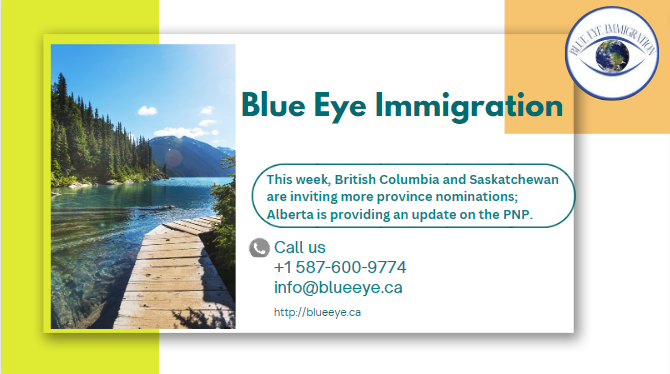In accordance with their Provincial Nominee Programs (PNPs), British Columbia, Saskatchewan, and Alberta had drawings this week, and Alberta also gave significant information regarding their PNP. See the nomination results below, along with information on program streams, invitee count, candidate cutoff scores, and more.
The British Columbian
Under its “Skilled Worker International Graduate (includes Express Entry British Columbia (EEBC) option)” stream, the British Columbia Provincial Nominee Program (BCPNP) conducted three targeted draws for certain vocations.
Immigration candidates with professional expertise in IT occupations received 104 invitations to apply (ITAs) in the first draw. Candidates in this draw had to have a minimum score of 94.
The second draw primarily targeted early childhood educators and assistants, as well as those working in the childcare industry. Candidates who scored at least 60 were awarded 61 ITAs in the draw.
Professionals with prior experience in the healthcare industry were the focus of the last draw. A minimum score of 60 was required for applicants to get one of 25 invites.
Throughout the year, British Columbia (B.C.) has consistently hosted draws. Like many other jurisdictions, British Columbia has targeted professions. Because the federal and provincial governments emphasize in-demand jobs through category-based selection for PNPs and in-demand occupations through Express Entry, candidates with professional expertise in these targeted occupations may be given preference when acquiring an ITA.
The Prairies
Results of the October 23rd immigration draw were made public by Saskatchewan, which used the Saskatchewan Immigrant Nominee Program (SINP) to conduct two distinct PNP lotteries.
The Occupations-In-Demand stream hosted the inaugural draw, inviting 40 applicants with a minimum score of 84 to submit an application for permanent residence.
A minimum score of 84 was required to be called to the second draw, which was conducted through the Express Entry-aligned stream for 59 applicants.
Assessments of educational credentials were given to candidates in both streams (ECA).
Through the Existing Work Permit stream, Saskatchewan has stated that it will be opening up more employment to people with intermediate and lower skill levels. Candidates working in more than 270 additional vocations are now qualified to apply for Saskatchewan permanent residency according to this new regulation.
Canada Alberta
Through its PNP, the Atlantic Advantage Immigration Program (AAIP), Alberta recently provided an update on immigration during the year.
As of November 7, 2023, 9,200 applicants have been invited by the AAIP. 9,750 immigration applicants were allotted annually for this year, and the program is now on schedule to invite all of them by the end of the year. With Express Entry aligned and other streams making up the difference, non-Express Entry streams account for more than half of these allocations. According to the provincial government, more spaces are now available in the Alberta Opportunity Stream and Rural Renewal Stream after being reallocated from streams with lesser demand.
With a thriving population, robust economy, and lower tax rates than the rest of Canada, Alberta is one of the provinces that is expanding the quickest in the country. Alberta now anticipates allocating more than 10,000 immigrants annually (per year) between 2024 and 2025.
The PNP’s increasing relevance
The PNP was established to promote immigration’s benefits across the nation. Beginning in 1998, the program is expected to overtake other government economic initiatives as Canada’s primary route for economic immigrants by 2025.
The program’s increasing popularity suggests that the IRCC wishes to encourage immigration to places where there may be a larger demand for newcomers. Nowadays, prospective immigrants to Canada would wish to look at both the federal and provincial immigration processes, because the latter are becoming increasingly important in Canada’s immigration initiatives.
